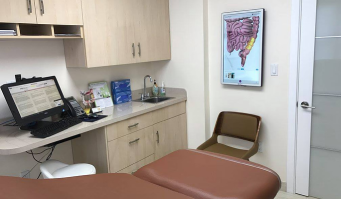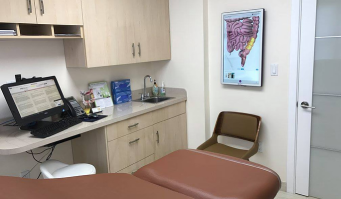Blood in Stool
- Over 1000 5 Star Reviews
- Personalized Care
- Award Winning GI Specialist
What is Blood in Stool?
Blood in stool can vary in color depending on its origin:
Bright red: This suggests bleeding in the lower digestive tract, specifically the colon, rectum, or anus. The rectum is the passage connecting your colon to the anus, which is the body’s opening for waste elimination.
Dark red or brown: This indicates bleeding in the upper digestive tract, including the higher parts of the colon and the small intestine.
Black (melena): This suggests bleeding in the upper digestive system, possibly from a stomach ulcer.
In some cases, blood in stool might be invisible to the naked eye but detectable under a microscope. This is known as occult bleeding.
It’s important to note that certain foods can also alter stool color, without indicating the presence of blood. Examples include beets, tomatoes, blackberries, and supplements like iron or multivitamins.
If you experience any blood in your stool, regardless of color, it’s crucial to consult a healthcare professional for prompt evaluation and diagnosis.
CAUSES OF Blood in Stool
- Hemorrhoids.
- Anal fissure.
- Inflammatory bowel disease (IBD).
- Ischemic colitis.
- Diverticular disease.
- Sexually transmitted infection (STI).
- Peptic ulcer.
- Polyps or cancer.
- Esophageal problems.
- Blood thinners.
- Endometriosis.
- Gastrointestinal bleeding
Symptoms of Blood in Stool
- Vomiting blood
- Black, tarry stool
- Rectal bleeding
- Dizziness or fainting
- Difficulty breathing
- Chest pain
- Stomach pain
Diagnosis of Blood in Stool
Diagnostic Tests for Digestive Tract Bleeding:
Several tests can help your doctor identify the source of bleeding in your digestive tract. Here’s a brief overview:
Upper Digestive Tract Tests:
- Nasogastric lavage:
- Esophagogastroduodenoscopy (EGD
- Enteroscopy:
- Barium X-ray:
- Radionuclide scanning:
- Angiography:
Lower Digestive Tract Tests:
- Colonoscopy
- Anoscopy
- Proctoscopy:
- Flexible sigmoidoscopy:
- Rectal culture swab:
- Stool test
- Imaging test
- Laparotomy: Surgery to open and examine the abdomen may be necessary if other tests are inconclusive.
Treatment of Blood in Stool
Treatment options may include:
- Medications:
- Antibiotics
- Acid-reducing medications
- Anti-inflammatory drugs
- Surgery:
- Polypectomy:
- Resection:

“Thank you for visiting Forest Hills Gastroenterology & Liver Disease, my goal is to treat my patients in a highly personalized manner and I am dedicated to give you the utmost attention and respect that you deserve. For more infromation on this disease or to schedule a consultation with me, please give us a call or book a tele-health appointment online.”
Albert Shalomov
Dr. Albert Shalomov, MD
Disclaimer: Educational Infromation, Not Medical Advice
It’s important to remember that the information provided here is intended for educational purposes only and should not be misconstrued as definitive medical advice. Always seek the guidance of a qualified gastroenterologist for accurate diagnosis and treatment of any specific gastrointestinal condition. Only trained healthcare professionals can provide personalized recommendations and ensure your well-being.




